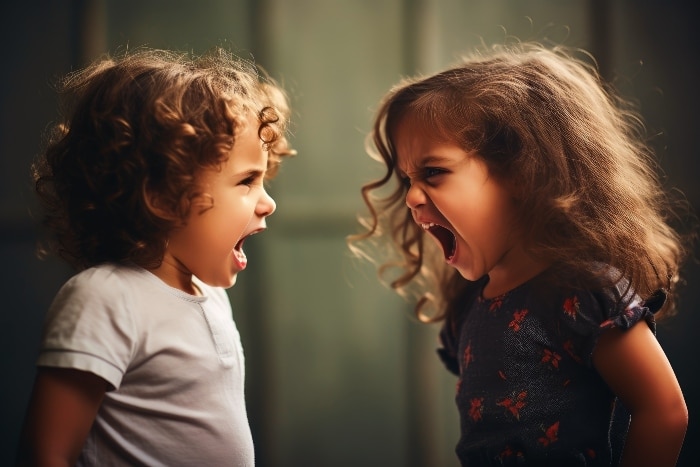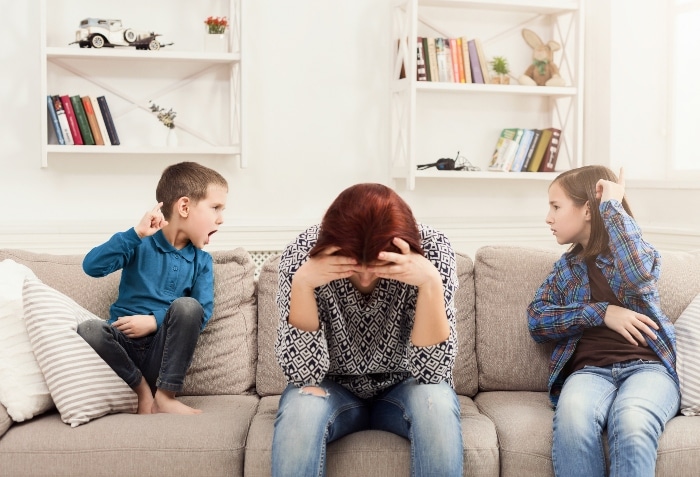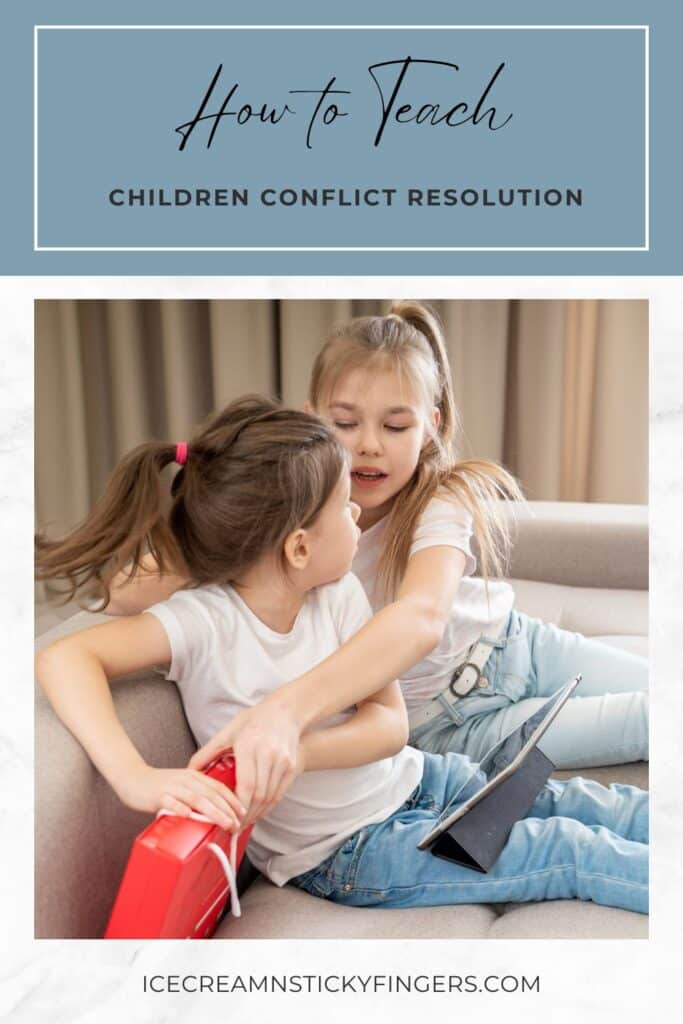Do you want to know how to teach children conflict resolution? Conflict is a normal part of growing up. Whether it’s a disagreement over toys, turns, or opinions, children need guidance to learn how to handle these situations calmly and respectfully. Teaching conflict resolution not only reduces fights and tantrums but also helps children build empathy, communication skills, and emotional intelligence — essential tools for life.
Below are ten detailed strategies, complete with examples, practical activities, and suggestions for different age levels to make teaching children conflict resolution easier.

Model Positive Behavior
Children learn more from what they see than from what they are told. Adults are their most powerful role models. When you manage your own frustrations calmly and treat others with respect, children internalize that behavior.
How to Model:
- When you disagree with someone (even your child), show active listening and calm communication.
- Use phrases like:
- “I can see you’re upset, let’s talk about this calmly.”
- “I understand your point, here’s how I feel…”
- If you lose your temper, apologize afterward. This shows children that making mistakes is okay — what matters is taking responsibility.
Why It Works:
Children absorb social behaviors subconsciously. Modeling shows them that disagreements are normal and can be resolved through communication, not aggression.
Teach Empathy
Empathy helps children recognize emotions — both their own and others’. It’s the foundation for kindness, understanding, and fair problem-solving.
How to Teach It:
- Label emotions: “You look sad because your friend took your crayon.”
- Ask reflective questions: “How do you think your friend felt when you said that?”
- Use mirrors or storybooks to help children identify facial expressions and body language.
- Encourage perspective-taking: “If that happened to you, what would you want your friend to do?”
Activity Idea:
Play “Feelings Charades” — act out emotions like happy, angry, frustrated, proud — and have children guess. Discuss situations that might cause those feelings.
Why It Works:
When children understand that others have feelings too, they become more motivated to cooperate and resolve conflicts peacefully.
Encourage Open and Respectful Communication
Children often resort to shouting or hitting because they don’t know how to express themselves. Teaching them language for emotions gives them tools to communicate more effectively.
Teach “I” Statements:
Instead of “You’re mean!” → teach “I feel upset when you don’t let me play.”
Instead of “You never share!” → teach “I want a turn, too.”
Tips:
- Practice this regularly through role-playing.
- Write sentence starters on cards:
- “I feel ___ when ___.”
- “Can we find a way to ___?”
- Praise attempts to use respectful language, even if imperfect.
Why It Works:
“I” statements help children take responsibility for their emotions without blaming others, which keeps conversations constructive and solutions-focused.
Teach the Problem-Solving Process
Children often see conflicts in black-and-white terms — “I’m right, you’re wrong.” You can teach them to view disagreements as opportunities to find mutual solutions.
5-Step Problem-Solving Process:
- Calm down – Take deep breaths or count to 10.
- Identify the problem – “What are we arguing about?”
- Listen to each other’s feelings and needs.
- Brainstorm solutions – “What can we both agree on?”
- Choose one and try it out.
Example:
Two kids fighting over a toy truck might decide to set a timer and take turns. The adult can say, “You both want the truck. What’s one way you can share it?”
Why It Works:
It teaches logical thinking, negotiation, and compromise — lifelong interpersonal skills.

Use Stories, Books, and Media to Discuss Conflict Resolution with Your Child
Stories are powerful teaching tools. They allow children to see conflicts and resolutions play out safely in someone else’s world.
Book Ideas:
- “Enemy Pie” by Derek Munson — teaches forgiveness and friendship.
- “How to Be a Friend” by Laurie Krasny Brown — explains healthy friendships and conflict.
- “Words Are Not for Hurting” by Elizabeth Verdick — encourages kind communication.
After Reading:
Ask reflective questions like:
- “What was the problem in the story?”
- “How did the characters solve it?”
- “What would you have done differently?”
Why It Works:
Children relate emotionally to characters, which helps them internalize lessons in a non-confrontational, memorable way.
Teach Active Listening
Active listening is more than hearing words — it’s showing that you care about what the other person says.
How to Practice:
- Have children face each other, make eye contact, and take turns speaking.
- Use a “listening object” (like a soft ball) that shows whose turn it is to talk.
- Encourage them to summarize: “So you’re saying you felt sad because I didn’t wait for you?”
Why It Works:
Active listening builds respect and ensures both sides feel heard, reducing emotional defensiveness.
Role-Play Real-Life Scenarios
Role-playing allows children to practice conflict resolution before they face real situations.
Examples to Role-Play:
- “Two friends want the same toy.”
- “Someone doesn’t want to share.”
- “A classmate said something that hurt your feelings.”
Add Complexity as They Grow:
For older children, use more advanced conflicts — misunderstandings, gossip, or group disagreements — and let them brainstorm ways to respond calmly.
Why It Works:
It provides a safe environment for children to experiment with words and actions, making them more confident and capable when real conflicts arise.
Set Clear Rules and Expectations
Children need consistent boundaries for behavior. Establishing simple, clear rules gives them structure and predictability when conflicts occur.
Examples of Conflict Rules:
- Use calm voices.
- Listen to others before talking.
- No name-calling or hitting.
- Work together to find a fair solution.
Tip:
Create a “Peace Corner” or “Calm Zone” — a quiet space with soft toys, books, or breathing cards where children can cool down before talking.
Why It Works:
Rules help children understand acceptable behavior and provide a routine response to emotional moments.
Reinforce Positive Behavior
When children successfully manage conflicts, acknowledge it! Praise motivates them to repeat positive actions.
Ways to Reinforce:
- Verbal praise: “I love how you listened to your friend.”
- Stickers or reward charts for teamwork or problem-solving.
- Celebrate peaceful resolutions in class meetings or at home.
Why It Works:
Positive reinforcement strengthens new habits and makes children proud of their growth in communication and self-control.
Be Patient and Consistent
Learning to resolve conflicts peacefully takes time and practice. Children will make mistakes — they might shout, cry, or withdraw. That’s normal. Your consistent response helps them learn that conflicts are not about winning or losing, but about understanding and working together.
Tips for Adults:
- Stay calm even when children are upset.
- Guide rather than punish — use mistakes as learning moments.
- Revisit past conflicts and talk about what went well and what could be done differently next time.
Why It Works:
Consistency builds trust and emotional safety. Over time, children internalize these lessons and become more capable of handling conflicts independently.
💡 Bonus Ideas for Teachers and Parents to Help Teach Children Conflict Resolution
- Create a “Conflict Toolbox” – Include tools like feeling charts, timers, and “peace talk” cards.
- Hold regular “Circle Time” discussions – Let children share feelings, practice listening, and discuss common social challenges.
- Model apologies and forgiveness – Teach that saying sorry and accepting apologies are signs of strength, not weakness.
Teaching children conflict resolution is more than helping them stop arguments — it’s giving them lifelong tools for empathy, communication, and cooperation. When children learn to express their feelings, listen to others, and seek fair solutions, they grow into more compassionate and confident individuals. These skills build stronger friendships, healthier classrooms, and more peaceful homes. By modeling positive behavior, guiding problem-solving, and celebrating small successes, adults can empower children to handle challenges with understanding and respect. Ultimately, conflict resolution is not just about ending disagreements — it’s about teaching children how to build harmony and kindness in every part of their lives. We hope that you learned how to teach your children conflict resolution and can use these tricks to make things easier in your home.







